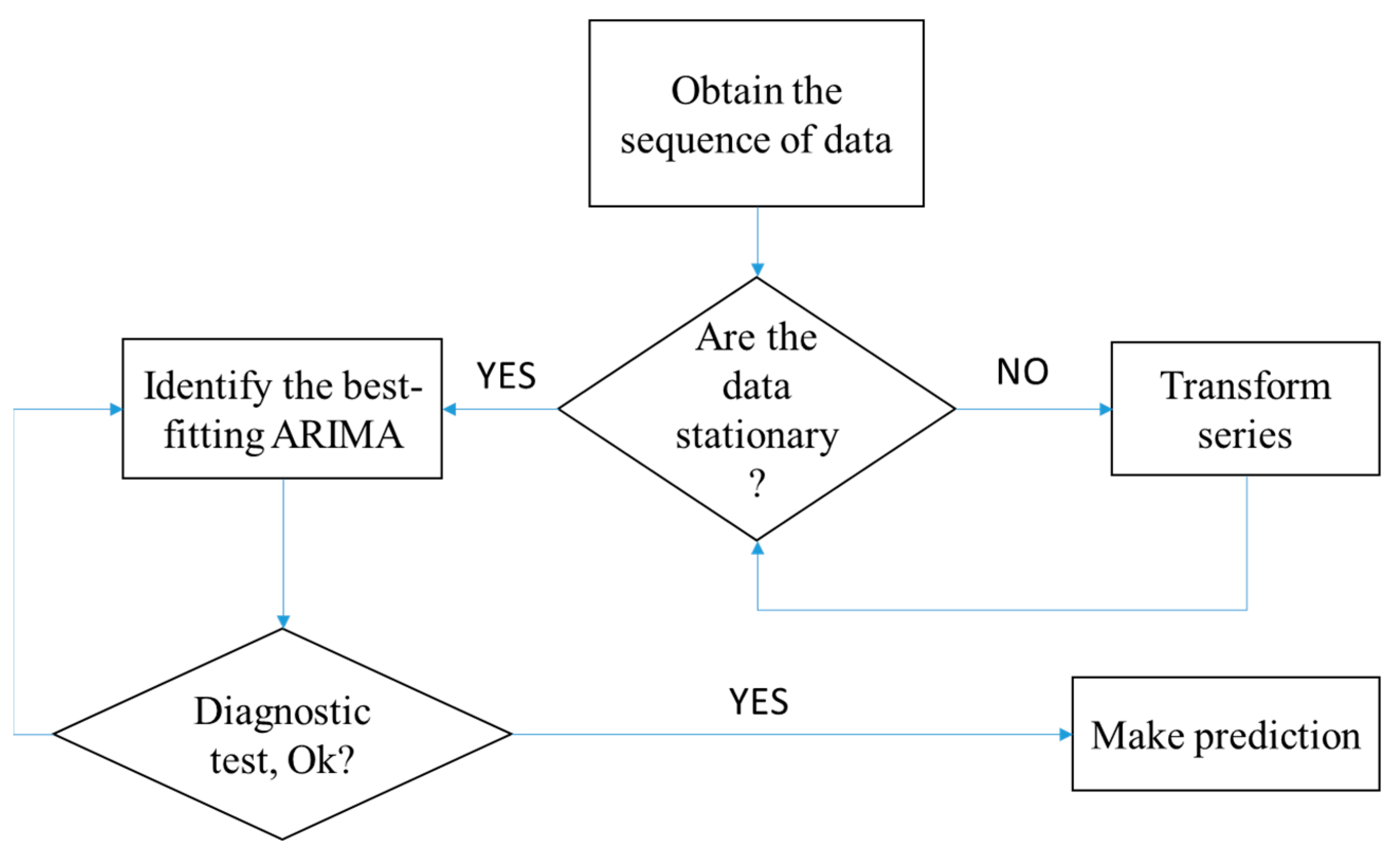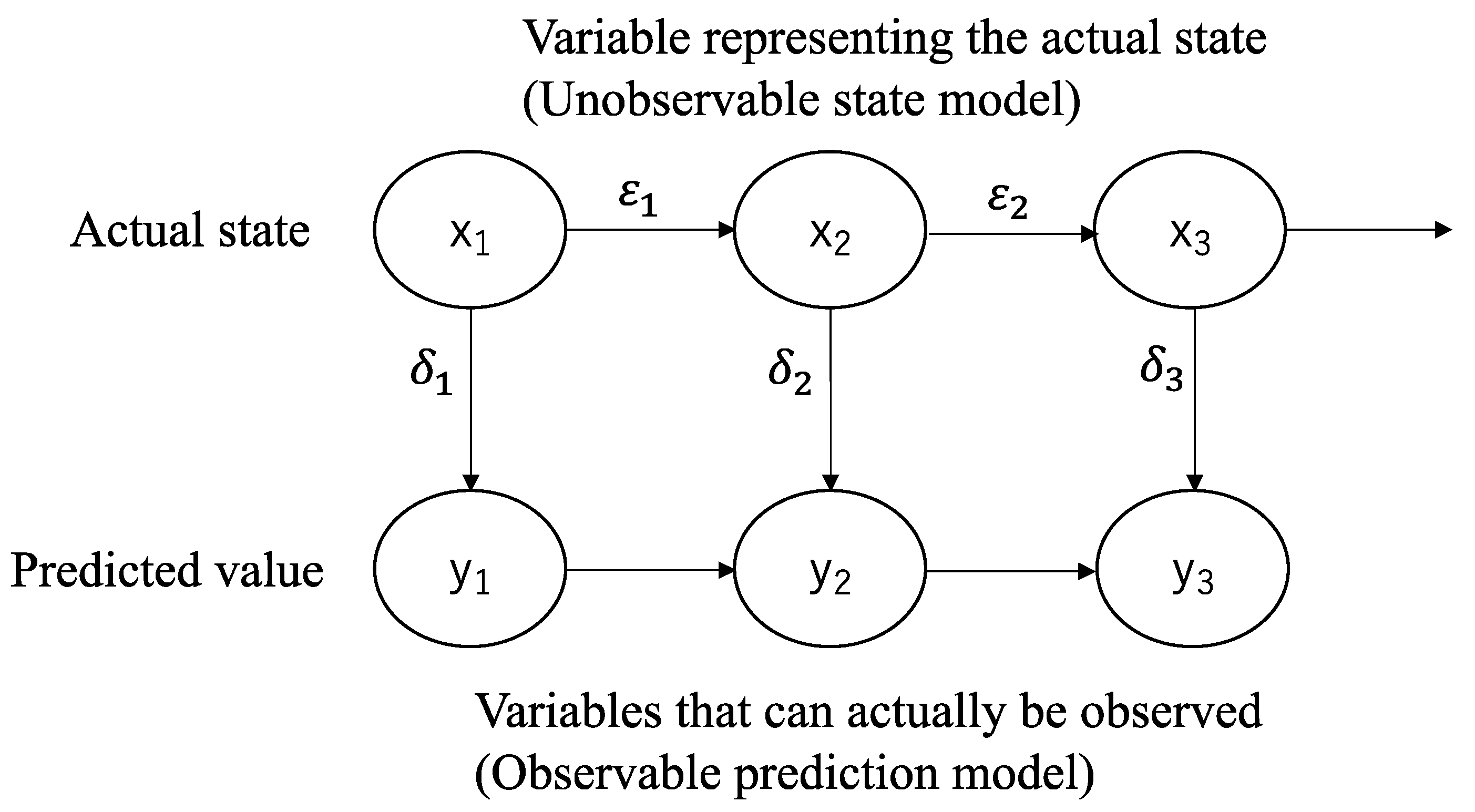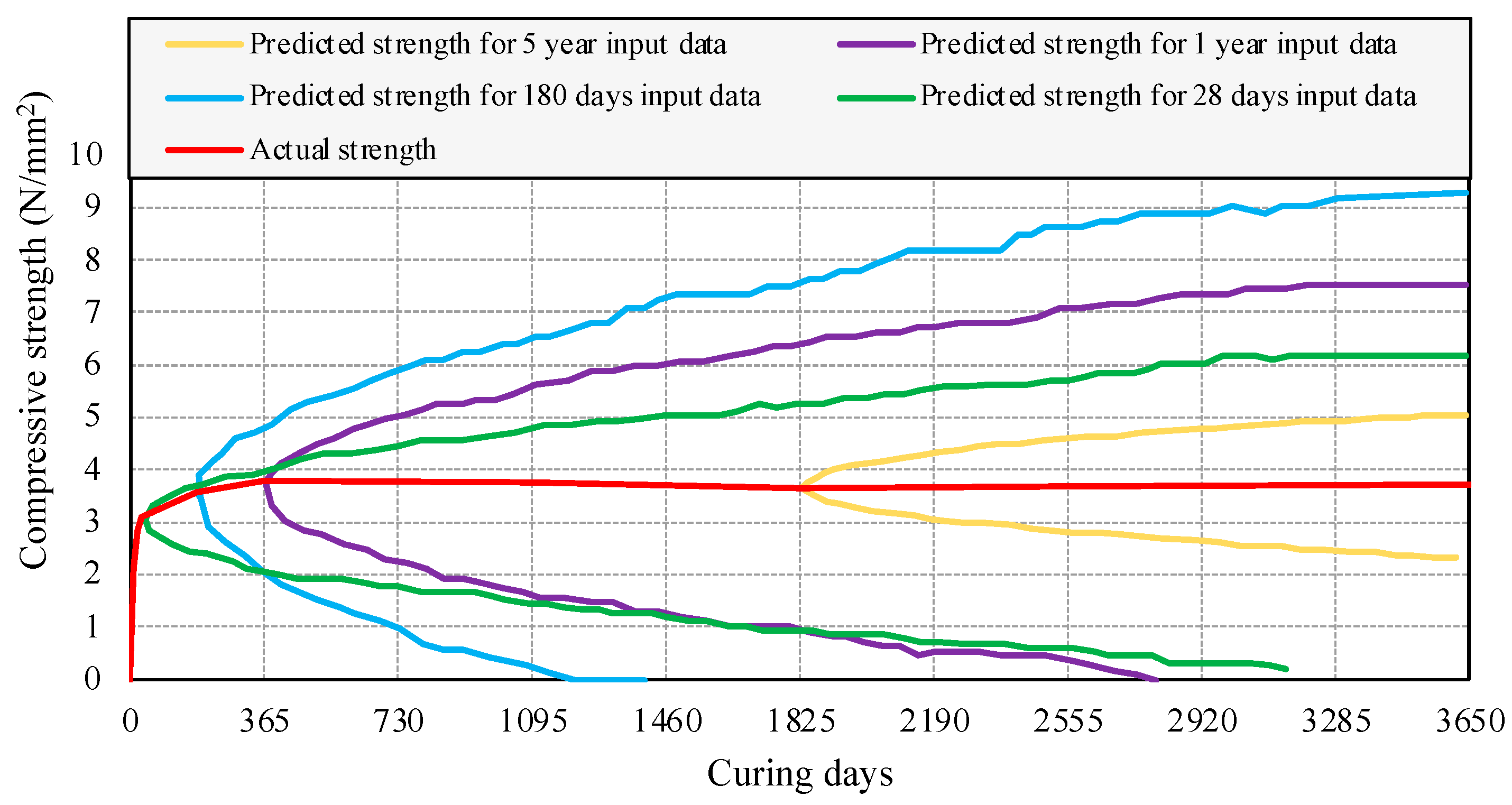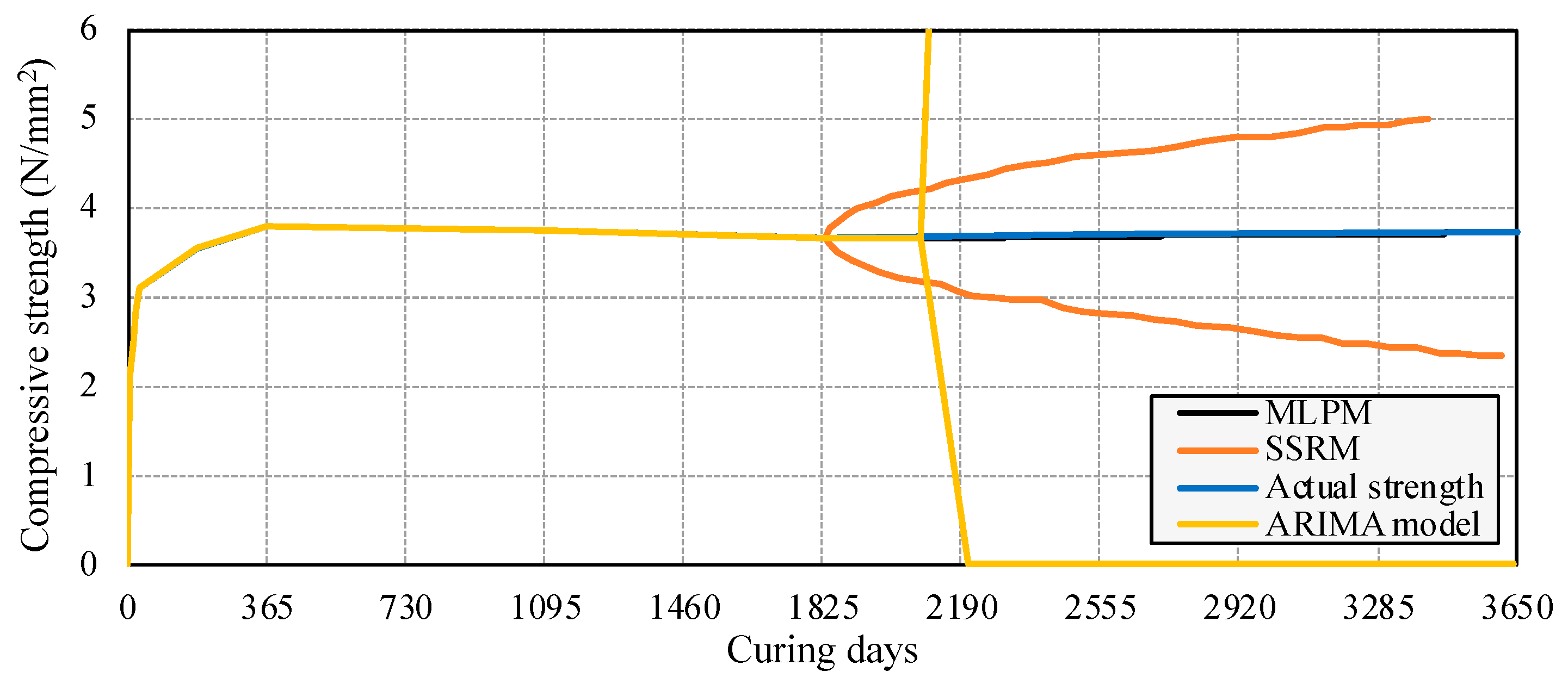Time-Series Prediction of Long-Term Sustainability of Grounds Improved by Chemical Grouting
Abstract
1. Introduction
2. Methodologies
2.1. Autoregressive Integrated Moving Average (ARIMA) Model
2.2. State-Space Representation (SSR) Model
2.3. Machine Learning Predictive (MLP) Model
3. Results and Discussion
3.1. Uniaxial Compression Strength of the Improved Body
3.2. Prediction Results from the ARIMA Model
3.3. Prediction Results by SSR Model
3.4. Prediction Results by MLP Model
3.5. Comparison between the Three Different Models
4. Conclusions and Future Studies
- (1)
- The output results of the SSR model were moderate at their best. The accuracy increased with the increase in the amount of input data amount, although the output results were still generated in a range instead of a single value. However, the 10-year period prediction from 28 days of data was found to be more accurate than that from the 180 days and 1-year input data.
- (2)
- Although the MLP model generated the smallest errors among the three models, the margin of error remained and was only omitted when the highly fluctuating data were omitted from the input data. This might bring some sort of conflict in the scientific community regarding its reliability.
- (3)
- Since the MLP model can generate reliable results only for equivalent input data, the SSR model might be a better choice for long-term forecasting with a small amount of input data. In addition, since the chances of availability of long-term data, such as 5-year period data, are very low in all cases, the MLP method might not be favored in all situations.
- (4)
- The ARIMA model produced the most accurate predictions for short periods when the amount of input data was large, such as the case of 5-year input data, where the results for 730 days were more accurate than those using the MLP model.
Author Contributions
Funding
Institutional Review Board Statement
Informed Consent Statement
Data Availability Statement
Conflicts of Interest
References
- Sharma, M.; Satyam, N.; Reddy, K.R. State of the art review of emerging and biogeotechnical methods for liquefaction mitigation in sands. J. Hazard. Toxic Radioact. Waste 2021, 25, 03120002. [Google Scholar] [CrossRef]
- Intui, S.; Inazumi, S.; Soralump, S. Sustainability of soil/ground environment under changes in groundwater level in Bangkok plain, Thailand. Sustainability 2022, 14, 10908. [Google Scholar] [CrossRef]
- Inazumi, S.; Hashimoto, R.; Shinsaka, T.; Nontananandh, S.; Chaiprakaikeow, S. Applicability of additives for ground improvement utilizing fine powder of waste glass. Materials 2021, 14, 5169. [Google Scholar] [CrossRef]
- Shakya, S.; Inazumi, S.; Nontananandh, S. Potential of computer-aided engineering in the design of ground improvement technologies. Appl. Sci. 2022, 12, 9675. [Google Scholar] [CrossRef]
- Nontananandh, S.; Kuwahara, S.; Shishido, K.; Inazumi, S. Influence of perforated soils on installation of new piles. Appl. Sci. 2022, 12, 7712. [Google Scholar] [CrossRef]
- Inazumi, S.; Kuwahara, S.; Nontananandh, S.; Jotisankasa, A.; Chaiprakaikeow, S. Numerical analysis for ground subsidence caused by extraction holes of removed piles. Appl. Sci. 2022, 12, 5481. [Google Scholar] [CrossRef]
- Nakao, K.; Inazumi, S.; Takaue, T.; Tanaka, S.; Shinoi, T. Evaluation of discharging surplus soils for relative stirred deep mixing methods by MPS-CAE analysis. Sustainability 2022, 14, 58. [Google Scholar] [CrossRef]
- Duan, W.; Congress, S.S.C.; Cai, G.; Liu, S.; Dong, X.; Chen, R.; Liu, X. A hybrid GMDH neural network and logistic regression framework for state parameter–based liquefaction evaluation. Can. Geotech. J. 2021, 99, 1801–1811. [Google Scholar] [CrossRef]
- Duan, W.; Congress, S.S.C.; Cai, G.; Zhao, Z.; Liu, S.; Dong, X.; Chen, R.; Qiao, H. Prediction of in situ state parameter of sandy deposits from CPT measurements using optimized GMDH-type neural networks. Acta Geotech. 2022, 17, 4515–4535. [Google Scholar] [CrossRef]
- Padmanabhan, G.; Shanmugam, G.K. Liquefaction and reliquefaction resistance of saturated sand deposits treated with sand compaction piles. Bull. Earthq. Eng. 2021, 19, 4235–4259. [Google Scholar] [CrossRef]
- Nakao, K.; Inazumi, S.; Takahashi, T.; Nontananandh, S. Numerical simulation of the liquefaction phenomenon by MPSM-DEM coupled CAES. Sustainability 2022, 14, 7517. [Google Scholar] [CrossRef]
- Aksoy, C.O. Chemical injection application at tunnel service shaft to prevent ground settlement induced by groundwater drainage: A case study. Int. J. Rock Mech. Min. Sci. 2008, 45, 376–383. [Google Scholar] [CrossRef]
- Pogaku, R.; Mohd, F.N.H.; Sakar, S.; Cha, Z.W.; Musa, N.; Awang, T.D.N.A.; Morris, L.O. Polymer flooding and its combinations with other chemical injection methods in enhanced oil recovery. Polym. Bull. 2018, 75, 1753–1774. [Google Scholar] [CrossRef]
- Xu, B.; Yi, Y. Soft clay stabilization using ladle slag-ground granulated blast furnace slag blend. Appl. Clay Sci. 2019, 178, 105136. [Google Scholar] [CrossRef]
- Yi, Y.; Li, C.; Liu, S. Alkali-activated ground-granulated blast furnace slag for stabilization of marine soft clay. J. Mater. Civ. Eng. 2015, 27, 04014146. [Google Scholar] [CrossRef]
- Sun, X.; Yi, Y. Utilization of incineration bottom ash, waste marine clay, and ground granulated blast-furnace slag as a construction material. Resour. Conserv. Recycl. 2022, 182, 106292. [Google Scholar] [CrossRef]
- Güneyisi, E.; Gesoğlu, M. A study on durability properties of high-performance concretes incorporating high replacement levels of slag. Mater. Struct. 2008, 41, 479–493. [Google Scholar] [CrossRef]
- Hadj-sadok, A.; Kenai, S.; Courard, L.; Darimont, A. Microstructure and durability of mortars modified with medium active blast furnace slag. Constr. Build. Mater. 2011, 25, 1018–1025. [Google Scholar] [CrossRef]
- Nazari, A.; Riahi, S. RETRACTED: Splitting tensile strength of concrete using ground granulated blast furnace slag and SiO2 nanoparticles as binder. Energy Build. 2011, 43, 864–872. [Google Scholar] [CrossRef]
- Shi, X.; Yang, Z.; Liu, Y.; Cross, D. Strength and corrosion properties of portland cement mortar and concrete with mineral admixtures. Constr. Build. Mate Rials 2011, 25, 3245–3256. [Google Scholar] [CrossRef]
- Shi, X.; Xie, N.; Fortune, K.; Gong, J. Durability of steel reinforced concrete in chloride environments: An overview. Constr. Build. Mater. 2012, 30, 125–138. [Google Scholar] [CrossRef]
- Teng, S.; Lim, T.Y.D.; Sabet, D.B. Durability and mechanical properties of high strength concrete incorporating ultra-fine ground granulated blast-furnace slag. Constr. Build. Mater. 2013, 40, 875–881. [Google Scholar] [CrossRef]
- Song, B.; Zhang, S.; Zhang, D.; Fan, G.; Yu, W.; Zhao, Q.; Liang, S. Inorganic cement grouting for reinforcing triangular zone of highly gassy coal face with large mining height. Energies 2018, 11, 2549. [Google Scholar] [CrossRef]
- Atangana, N.P.G.; Shen, J.S.; Modoni, G.; Arulrajah, A. Recent advances in hori-zontal jet grouting (HJG): An overview. Arab. J. Sci. Eng. 2018, 43, 1543–1560. [Google Scholar] [CrossRef]
- Qiu, J.; Liu, H.; Lai, J.; Lai, H.; Chen, J.; Wang, K. Investigating the long-term settlement of a tunnel built over improved loessial foundation soil using jet grouting technique. J. Perform. Constr. Facil. 2018, 32, 04018066. [Google Scholar] [CrossRef]
- Hwang, J.H.; Lu, C.C. A semi-analytical method for analyzing the tunnel water inflow. Tunn. Undergr. Space Technol. 2007, 22, 39–46. [Google Scholar] [CrossRef]
- Jacob, C.E.; Lohmann, S.W. Non steady flow to a well of constant drawdown in an extensive aquifer. Trans. Am. Geophys. Union 1952, 33, 559–569. [Google Scholar] [CrossRef]
- Kazemian, S.; Huat, B.B.; Arun, P.; Barghchi, M. A review of stabilization of soft soils by injection of chemical grouting. Aust. J. Basic Appl. Sci. 2010, 4, 5862–5868. [Google Scholar]
- Chandra, M.; Shahab, F.; Kek, V.; Rajak, S. Selection for additive manufacturing using hybrid MCDM technique considering sustainable concepts. Rapid Prototyp. J. 2022, 28, 1297–1311. [Google Scholar] [CrossRef]
- Khorsani, M.; Loy, J.; Ghasemi, A.H.; Sharabian, E.; Leary, M.; Mirafzal, H.; Cochrane, P.; Rolfe, B.; Gibson, I. A review of Industry 4.0 and additive manufacturing synergy. Rapid Prototyp. J. 2022, 28, 1462–1475. [Google Scholar] [CrossRef]
- Chatfield, C. The Analysis of Time Series: An Introduction, 6th ed.; Chapman and Hall/CRC: London, UK, 2003. [Google Scholar] [CrossRef]
- Aladağ, E. Forecasting of particulate matter with a hybrid ARIMA model based on wavelet transformation and seasonal adjustment. Urban Clim. 2021, 39, 100930. [Google Scholar] [CrossRef]
- McElroy, T. Finite sample revision variances for ARIMA model-based signal extraction. J. Off. Stat. 2008, 24, 451–467. [Google Scholar]
- Durbin, J.; Koopman, S.J. Time Series Analysis by State Space Methods, 2nd ed.; Oxford Statistical Science Series 38; Oxford University Press: Oxford, UK, 2012. [Google Scholar]
- Duan, L.; Huang, M.; Zhang, L. Use of a state-space approach to predict soil water storage at the hillslope scale on the Loess Plateau, China. CATENA 2016, 137, 563–571. [Google Scholar] [CrossRef]
- Wendroth, O.; Reynolds, W.D.; Vieira, S.R.; Reichardt, K.; Wirth, S. Chapter 11 Statistical approaches to the analysis of soil quality data. Dev. Soil Sci. 1997, 25, 247–276. [Google Scholar] [CrossRef]
- Georgakakos, A.P.; Georgakakos, K.P.; Baltas, E.A. A state-space model for hy-drologic river routing. Water Resour. Res. 1990, 26, 827–838. [Google Scholar] [CrossRef]
- Chiheb, S.; Kherif, O.; Teguar, M.; Mekhaldi, A.; Harid, N. Transient behaviour of grounding electrodes in uniform and in vertically stratified soil using state space rep-resentation. IET Sci. Meas. Technol. 2018, 12, 427–435. [Google Scholar] [CrossRef]
- Hagiwara, J. Time Series Analysis for the State-Space Model with R/Stan; Springer: Singapore, 2021. [Google Scholar] [CrossRef]
- Brockwell, P.J.; Davis, R.A. Introduction to Time Series and Forecasting; Springer: Berlin/Heidelberg, Germany, 2002. [Google Scholar] [CrossRef]
- Dai, J.; Chen, S. The application of ARIMA model in forecasting population data. J. Phys. Conf. Ser. 2019, 1324, 012100. [Google Scholar] [CrossRef]
- Jordan, M.I.; Mitchell, T.M. Machine learning: Trends, perspectives, and prospects. Science 2015, 349, 255–260. [Google Scholar] [CrossRef]
- Butler, K.T.; Davies, D.W.; Cartwright, H.; Isayev, O.; Walsh, A. Machine learning for molecular and materials science. Nature 2018, 559, 547–555. [Google Scholar] [CrossRef]
- Puri, N.; Prasad, H.D.; Jain, A. Prediction of geotechnical parameters using ma-chine learning techniques. Procedia Comput. Sci. 2018, 125, 509–517. [Google Scholar] [CrossRef]
- Inazumi, S.; Intui, S.; Jotisankasa, A.; Chaiprakaikeow, S.; Kojima, K. Artificial intelligence system for supporting soil classification. Results Eng. 2020, 8, 100188. [Google Scholar] [CrossRef]
- Abe, S. Introduction of support vector machines for pattern classification—VI: Current topics. Syst. Control Inf. 2009, 53, 205–210. [Google Scholar] [CrossRef]
- Müller, A.C.; Guido, S. Introduction to Machine Learning with Python: A Guide for Data Scientists; O’Reilly Media Inc.: Sebastopol, CA, USA, 2016. [Google Scholar]
- Naganna, S.R.; Deka, P.C. Support vector machine applications in the field of hydrology: A review. Appl. Soft Comput. 2014, 19, 372–386. [Google Scholar] [CrossRef]
- Raschka, S.; Patterson, J.; Nolet, C. Machine learning in Python: Main developments and technology trends in data science, machine learning, and artificial intelligence. Information 2020, 11, 193. [Google Scholar] [CrossRef]











Disclaimer/Publisher’s Note: The statements, opinions and data contained in all publications are solely those of the individual author(s) and contributor(s) and not of MDPI and/or the editor(s). MDPI and/or the editor(s) disclaim responsibility for any injury to people or property resulting from any ideas, methods, instructions or products referred to in the content. |
© 2023 by the authors. Licensee MDPI, Basel, Switzerland. This article is an open access article distributed under the terms and conditions of the Creative Commons Attribution (CC BY) license (https://creativecommons.org/licenses/by/4.0/).
Share and Cite
Inazumi, S.; Shakya, S.; Chio, C.; Kobayashi, H.; Nontananandh, S. Time-Series Prediction of Long-Term Sustainability of Grounds Improved by Chemical Grouting. Appl. Sci. 2023, 13, 1333. https://doi.org/10.3390/app13031333
Inazumi S, Shakya S, Chio C, Kobayashi H, Nontananandh S. Time-Series Prediction of Long-Term Sustainability of Grounds Improved by Chemical Grouting. Applied Sciences. 2023; 13(3):1333. https://doi.org/10.3390/app13031333
Chicago/Turabian StyleInazumi, Shinya, Sudip Shakya, Chifong Chio, Hideki Kobayashi, and Supakij Nontananandh. 2023. "Time-Series Prediction of Long-Term Sustainability of Grounds Improved by Chemical Grouting" Applied Sciences 13, no. 3: 1333. https://doi.org/10.3390/app13031333
APA StyleInazumi, S., Shakya, S., Chio, C., Kobayashi, H., & Nontananandh, S. (2023). Time-Series Prediction of Long-Term Sustainability of Grounds Improved by Chemical Grouting. Applied Sciences, 13(3), 1333. https://doi.org/10.3390/app13031333





